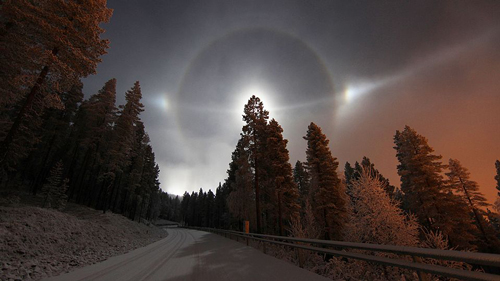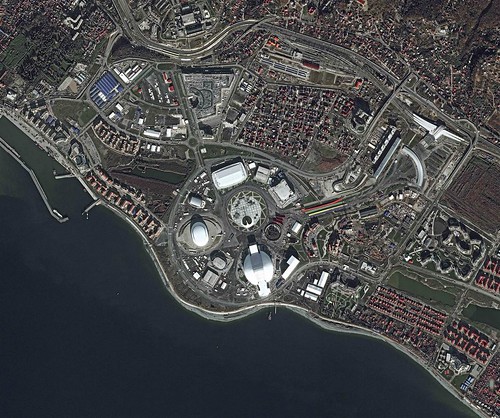Archive for the ‘Cool Stuff’ Category
Iridium’s Hot Spot
Tuesday, February 4th, 2014Nice job by the marketing folks at Iridium! No, I’m not talking about their cheesy video production. I’m talking about getting their story picked up by the traffic-mongers at Gizmodo.
Iridium GO! is a small Wi-Fi device that connects to the LEO system for connectivity anywhere in the world.
That’s hot.
Their write-up is practical and spot-on:
Satellite data speeds typically max out around 2.4 to 2.8Kbps (that’s KILObits). We’re talking early ’90s dial-up speeds here. So, you can send a picture, but it had better be very compressed, and you may require the patience of a zen master. SMS speeds, though, should be comparable to what you’re used to here in your bustling metropolis, and it should be fine for text-based emails, too.
The Iridium GO! will be rolling out sometime in the first half of 2014. The price will depend on retailers, but Iridium expects it to be under $800. Yeah, that’s steep, and don’t forget you’re going to need a plan in order to connect. Again, plan pricing will be set by retailers but Iridium estimates that they will begin around $35/month on the low end, and about $130/month on the high end for unlimited data.

Big Bang Monday: Whiteface
Monday, January 20th, 2014
Great photo by Mark Deff of Whiteface Mountain in New York, near Lake Placid and Site of the 1932 and 1980 Winter Olympics.
Who could forget beating the Soviets in hockey?
Follow The Pocket
Thursday, January 9th, 2014The Pocket Drone by AirDroid. Follows you — and your smarty pants phone — everywhere. Almost.
Carries a GoPro to film it all, too.
Relax, it’s just a prototype. Put your excitement to work with their Kickstarter campaign.
Increase NASA Funding
Friday, December 13th, 2013Great petition on WhiteHouse.gov.
Increase NASA funding. So we can discover new worlds, protect us from danger and to make dreams come true. CJ, Age: 6.5
Increase the funding for NASA so that children can dream of exploring the universe. Science funding is the future of our country.

Go ahead and sign it! Then get your kids a space suit.
See Ya, ISON.
Wednesday, December 4th, 2013Comet ISON’s Full Perihelion Pass, courtesy of NASA.
After several days of continued observations, scientists continue to work to determine and to understand the fate of Comet ISON: There’s no doubt that the comet shrank in size considerably as it rounded the sun and there’s no doubt that something made it out on the other side to shoot back into space. The question remains as to whether the bright spot seen moving away from the sun was simply debris, or whether a small nucleus of the original ball of ice was still there. Regardless, it is likely that it is now only dust.
Comet ISON, which began its journey from the Oort Cloud some 3 million years ago, made its closest approach to the sun on Nov. 28, 2013. The comet was visible in instruments on NASA’s Solar Terrestrial Relations Observatory, or STEREO, and the joint European Space Agency/NASA Solar and Heliospheric Observatory, or SOHO, via images called coronagraphs. Coronagraphs block out the sun and a considerable distance around it, in order to better observe the dim structures in the sun’s atmosphere, the corona. As such, there was a period of several hours when the comet was obscured in these images, blocked from view along with the sun. During this period of time, NASA’s Solar Dynamics Observatory could not see the comet, leading many scientists to surmise that the comet had disintegrated completely. However, something did reappear in SOHO and STEREO coronagraphs some time later — though it was significantly less bright.
Whether that spot of light was merely a cloud of dust that once was a comet, or if it still had a nucleus — a small ball of its original, icy material — intact, is still unclear. It seems likely that as of Dec. 1, there was no nucleus left. By monitoring its changes in brightness over time, scientists can estimate whether there’s a nucleus or not, but our best chance at knowing for sure will be if the Hubble Space Telescope makes observations later in December 2013.
Regardless of its fate, Comet ISON did not disappoint researchers. Over the last year, observatories around the world and in space gathered one of the largest sets of comet observations of all time, which should provide fodder for study for years to come. The number of space-based, ground-based, and amateur observations were unprecedented, with twelve NASA space-based assets observing over the past year.
Comet ISON Thanksgiving
Wednesday, November 27th, 2013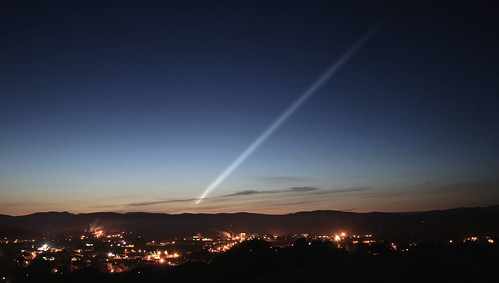
What a treat: we may be able to see the Comet ISON during the Thanksgiving Day holiday. Look for it near the horizon, but don’t look directly into the Sun (duh).

The image above, courtesy of ESA/NASA/SOHO, shows Comet ISON streaming toward the Sun.
In the early hours of Nov. 27, 2013, Comet ISON entered the field of view of the European Space Agency/NASA Solar and Heliospheric Observatory. In this picture, called a coronagraph, the bright light of the sun itself is blocked so the structures around it are visible. The comet is seen in the lower right; a giant cloud of solar material, called a coronal mass ejection or CME, is seen billowing out under the sun.
Comet ISON, which began its trip from the Oort cloud region of our solar system, will reach its closest approach to the sun on Thanksgiving Day, skimming just 730,000 miles above the sun’s surface.
NASA is tracking Comet ISON’s journey and hosting events to discuss what the public worldwide may see as the comet traverses the sun.
Here’s the best video yet…
Check out NASA’s Comet ISON Toolkit for more.
Think astronomers are excited? That’s an understatement. Look at the observation schedule.
Virgin Galactic’s First Flight: Global Broadcast
Friday, November 8th, 2013Visit NBCNews.com for breaking news, world news, and news about the economy
NBC Universal will broadcast the first Virgin Galactic flight live.
The Today show will be seen by millions and get incredible ratings. Hopefully, the first flight will be during sweeps.
Hiding From Satellites
Monday, November 4th, 2013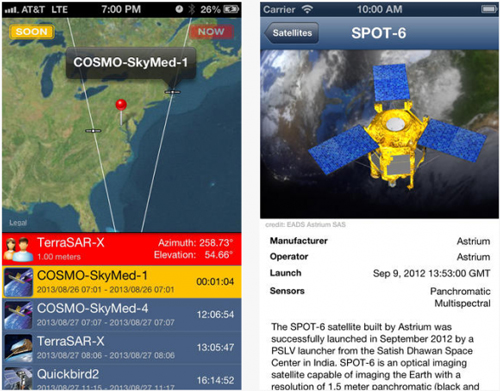
We’ve been fans of DLR’s Heavens Above site for years, a site that predicts when orbiting spacecraft are expected to be seen from Earth. Iridium flares are especially fun to predict to impress your friends.
Now we have s spacecraft prediction app of a more topical “spying” nature: SpyMeSat, a $2 app that predicts flyovers by observation satellites. Via SlashGear…
SpyMeSat was created by Orbit Logic, Inc., which specializes in supplying software to the aerospace and intelligence communities. The app, which was released last week, gets its data from organizations like NORAD, but it doesn’t use any classified information. In other words, any terrorists or human rights abusers looking to hide from satellites already can access the info through other data sources. The app’s chief purpose is to gather all that data into one cheap app.
“We were careful to only include satellites that are unclassified and whose orbits are published by NORAD,” Orbit Logic president Alex Herz said. “Even the sensor data — resolution, etc. — was taken only from the websites published by the satellite operators. So everything SpyMeSat is using is open and public.”
The app is accurate to 16 meters. You can set SpyMeSat to give you alerts for any location, track satellites even when they’re not overhead, call up resolution specs for each model, and learn about their various on-board sensors. Satellite models in the database are owned and operated by either public or private bodies, including the GeoEye, France’s SPOT-5, India’s CartoSat-2A, DigitalGlobe WorldView, and RADARSAT-2 of Canada.
It may save you some embarrassment.
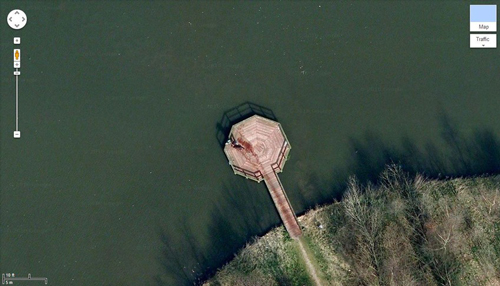
Big Bang Monday: Lunar Halo
Monday, November 4th, 2013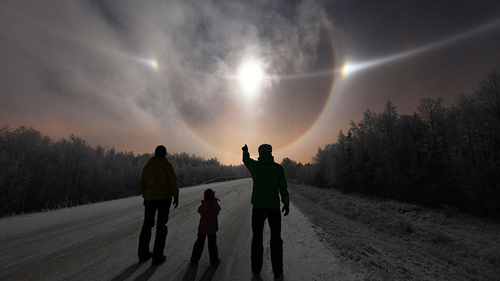
Photo by Pauli Hänninen
Simply spectacular, via Yle.
Laplanders got a rare and beautiful sight last Friday, when the Levi ski resort fired up its snow machines to start preparing its pistes. The Finnish resort usually has early and reliable snow, one of the reasons it is due to host the FIS World Cup in mid-November.
In the village of Sirkka, near Levi in the municipality of Kittilä, photographer Pauli Hänninen and his family were curious about the shining halos in the skies above them.
”It was cold and very foggy, the temperature was around -10 degrees Celsius,” said Hänninen. ”It was down to the snow-making, as dozens if not hundreds of canon were making the course for the World Cup and elsewhere.”
”When the clouds began to break, there were rainbow colours in the sky and a halo spanning 360 degrees!” continued Hänninen. ”It was worth taking a picture or two.”
